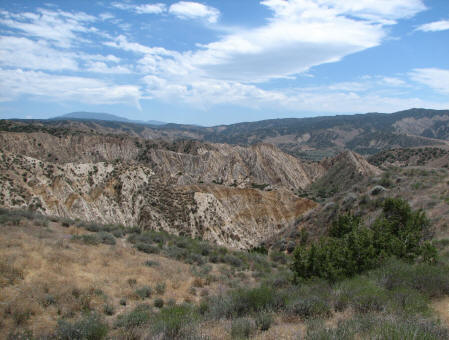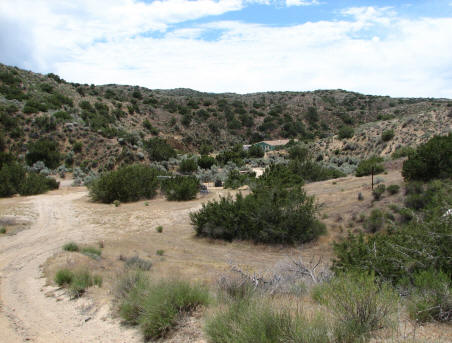|
June 1, 2006
FORESTWATCH, RURAL LANDOWNERS FORMALLY CHALLENGE BLM'S
OIL DRILLING AUCTION
Landowners Weren’t Notified of
the Federal Government’s Plans to Sell Mineral Rights to Oil
Companies on 19,780 Acres
THE CUYAMA VALLEY – An alliance of
rural landowners this week joined ForestWatch in filing a series
of challenges to an upcoming oil lease sale of
nearly 20,000 acres. The lease sale is the
first step towards allowing oil exploration and development in
this remote area flanked by the Los Padres National Forest, the
Bitter Creek National Wildlife Refuge, and the Carrizo Plain
National Monument.
The federal Bureau of Land
Management (BLM) announced the lease sale last month, and
scheduled the auction for June 14. During
the sale, the BLM will auction off the mineral rights on
thirty-two parcels in Santa Barbara, San Luis Obispo, Kern,
Ventura, and Kings counties. The winning bidder receives the
right to drill for oil, and bidding starts at only $2.00 per
acre.
This week, eight landowners and
ForestWatch formally filed challenges to the lease sale,
demanding that the BLM remove the most controversial lands from
the auction block.

This parcel on the
Rangeview Ranch is slated for auction. It overlooks the Bitter
Creek National Wildlife Refuge and the unique geologic
formations in Ballinger Canyon in the Los Padres National
Forest.
“We were
shocked to learn that the government could sell an oil lease on
our land without even notifying us,” said Penny Maines, who with
her husband Knute Johnson owns 60 acres of land along the
boundary of the Los Padres National Forest and the Bitter Creek
National Wildlife Refuge in Kern County, listed as Parcel
6-06-24 in the upcoming lease sale. “We purchased this property
because of its unspoiled natural beauty. The prospect of oil
rigs, pipelines and roads tearing up the landscape is
devastating.”
Very few of the lands targeted for
leasing are actually owned by the federal government. Eighty-five percent of the lands are privately-owned, with the
federal government holding title only to the underground mineral
rights.
Leasing split-estate lands has
become very controversial in other parts of the country like
Colorado, New Mexico, Wyoming, and Utah, where a similar
expansion of oil and gas drilling in remote areas is underway. This controversy stems from the fact that the BLM does not send
notice of the lease sale to landowners, allowing oil companies
to bid on split-estate leases without the consent – or even the
knowledge of – the surface landowner. The winning bidder
commonly holds the right to conduct geophysical exploration and
seismic tests, to construct roads to drill sites, to take water,
to dispose of wastewater, to install tanks and pipelines, and to
otherwise enter the private land for oil drilling.

An existing oil
facility in the lower Cuyama Valley. The June lease sale could
encourage the expansion of this development into the quiet,
pristine, and ecologically fragile upper valley.
The BLM tried to auction many of
these same parcels last year, but failed to properly notify the public
about how to formally challenge the lease sale. The agency
also forgot to conduct an environmental analysis to avoid
environmental damage caused by oil drilling. After ForestWatch
filed a formal protest, the agency cancelled the sale.
Now, the oil industry hopes to bid
on these lands in June. This time, the BLM prepared
an Environmental Assessment, but it does not satisfy strict
requirements designed to protect wildlife, clean air and water,
prime farmlands, and floodplains from oil damage. The BLM also
failed to notify ForestWatch, the affected landowners, or other
expert agencies, of the availability of the study and how to
submit comments to the agency. In a document sent to
ForestWatch, the BLM admitted that it went to great lengths to notify the oil and gas
industry.
“Once again, the oil industry
receives special treatment at the expense of public
participation and environmental protection,” said a spokesman
for ForestWatch. “The BLM has no respect for rural landowners or
the environment.”
Most of the parcels slated for
leasing are undeveloped, and many are under active cultivation
by farmers. Others are situated right along the boundaries of
protected lands like the Bitter Creek Wildlife Refuge, the Los
Padres National Forest, and the Carrizo Plain National
Monument. Allowing a network of oil rigs, pipelines, and
transmission wires will significantly change the rural landscape
of this area. In addition, each of the parcels provides habitat
for several threatened and endangered plants and animals,
including the San Joaquin kit fox, the California condor, the
California jewelflower, and the blunt-nosed leopard lizard,
according to the agency.

The Bitter Creek National Wildlife
Refuge is a 14,094-acre sanctuary set aside in 1985 to protect
feeding and roosting habitat for the California condor, one of
the world’s most endangered birds. Located in San Luis Obispo,
Kern, and Ventura counties, this refuge is the site where the
last female condor was captured in 1986 for the captive breeding
program. The refuge is off-limits to the public, but the BLM is
proposing to lease two parcels totaling 2,160 acres along the
refuge boundary.
“One of the reasons we bought the
property is because of the protection offered by the wildlife
refuge,” said Charles Fox, a Kern County resident who owns 80
acres near the refuge listed as Parcel 6-06-24 in the upcoming
lease sale. “It’s very peaceful country out there. We don’t
need oil wells and we certainly don’t want them on our
property.”

A small residence
on the Rangeview Ranch. The BLM failed to notify this property
owner, and dozens of others, about the upcoming lease sale, even
though their land could be directly affected by oil drilling.
The Carrizo Plain National
Monument in San Luis Obispo County was set aside by Presidential
Proclamation in 2001 to protect one the largest remaining
untouched ecosystem in the southern San Joaquin Valley. It
contains one of the highest concentrations of threatened and
endangered plants and animals in the state. The BLM is
proposing to lease four parcels totaling over 1,800 acres along
the monument boundary.
The Cuyama Valley is one of
region’s most rural areas, and federal biologists have
designated the upper reaches of the valley as an “Area of High
Ecological Significance” because of the abundance of rare plants
and animals. The area also serves as a gateway to the Los
Padres National Forest and the Dick Smith Wilderness Area. Six
parcels totaling nearly 7,300 acres are slated for auction
here. These parcels are located along or within a half-mile of
the forest boundary, and also within the viewshed of California
Scenic Highway 33. Some of them are within the floodplain of
the Cuyama River.

An agricultural
field is nestled between the Cuyama River and the Los Padres
National Forest.
What's Next
The land auction is scheduled for
June 14 in Sacramento, a five-hour drive from the lands on the
auction block. Every lease sale since 1999 has been held in
Bakersfield near the lands to be auctioned. This time,
officials have selected the Sacramento location, making it very
inconvenient for local landowners and other concerned citizens
to attend.
The BLM has 60 days to issue its
decisions on the protests. If the BLM agrees with the protests,
officials could remove the most controversial parcels from the
lease sale.
|

